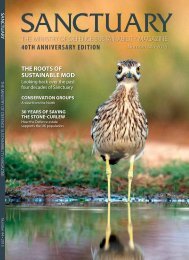SUSTAINABILITY
UC30G
UC30G
You also want an ePaper? Increase the reach of your titles
YUMPU automatically turns print PDFs into web optimized ePapers that Google loves.
AROUND THE REGIONS<br />
13<br />
Altcar<br />
Merseyside<br />
Training Camp<br />
moth Cossus cossus, the larvae feeding<br />
within poplar trees for up to seven<br />
years. Red-tipped clearwing<br />
Synanthedon formicaeformis, the larvae<br />
feeding on creeping willow. Lyme<br />
grass Chortodes elymi whose larvae<br />
feed on its namesake. Shore Wainscot<br />
Mythimnia litoralis whose larvae feed<br />
on marram grass and Cnephasia<br />
consperania a micro moth feeding<br />
within the flowers of Rosaceae and<br />
Compositae plants.<br />
Altcar ranges set within the sand dunes of Sefton Coast © Crown<br />
Altcar Training Camp, situated on the<br />
Sefton Coast a few miles north of<br />
Liverpool is a site of large open<br />
habitats and a foreshore of national<br />
importance. They include fore and<br />
fixed dunes, dune grassland, damp<br />
meadows, scrub and plantations which<br />
are mainly coniferous. Through this<br />
flows the river Alt with associated<br />
water edge herbaceous vegetation<br />
and trees.<br />
Work compiling lists of moth species<br />
found on site has been ongoing but<br />
over the last three years a more<br />
standardised approach has been<br />
applied to the recording. Using two<br />
separately spaced Mercury vapour<br />
moth traps on two or more nights<br />
during the spring, early and late<br />
summer and autumn have given a<br />
better picture of the moth<br />
populations. In addition to this,<br />
daytime visits to record day-flying<br />
moths, the collecting of larvae and leaf<br />
mines have added to the records.<br />
To date 367 different species of moths<br />
have been recorded not including<br />
sub-species or variations. 92 of these<br />
have been micro moths. 82 are listed<br />
as nationally ‘Local’ and of these 31 are<br />
also uncommon in Lancashire. In some<br />
cases they are found only here on the<br />
Sefton Coast as singles or in very small<br />
numbers. An example is ruddy highflier<br />
Hydriomena ruberata a grey willow<br />
feeder, recorded on site last year as a<br />
single and the first seen for over 35<br />
years in South Lancashire.<br />
Whilst these ‘Local’ species are of great<br />
interest a further seven are regarded as<br />
of national importance. Sandhill rustic<br />
Luperina nickerlii and grass eggar<br />
Lasiocampa trifolii are listed as<br />
Nationally Scarce B which means they<br />
are found in only 31-50 of the 550 10k<br />
squares which cover Great Britain. The<br />
larvae of the former feed on sand<br />
couch grass at the very front of the<br />
dune system and survive the salt spray<br />
and occasional sea water inundating,<br />
the latter feeds on creeping willow.<br />
The following five are listed as<br />
Nationally Scarce A and are found in<br />
only 16-30 of the 550 10k squares. Goat<br />
The Altcar conservation group meet<br />
twice a year to assess the land<br />
management issues which arise from<br />
the movement of troops across the<br />
land and balance the need to conserve<br />
the wildlife on this important site.<br />
Colonel Gordon Black has given his<br />
time and permission to enable this<br />
moth survey to take place including<br />
the invitation to other Lancashire Moth<br />
Group members to record on site. In<br />
particular on the three dates each year<br />
designated as National Moth nights.<br />
Richard B Walker<br />
County Moth Recorder (VC59) and<br />
member of the Altcar Conservation<br />
Advisory Group<br />
Red-tipped clearwing © Richard Walker<br />
86<br />
Sanctuary 44 • 2015



